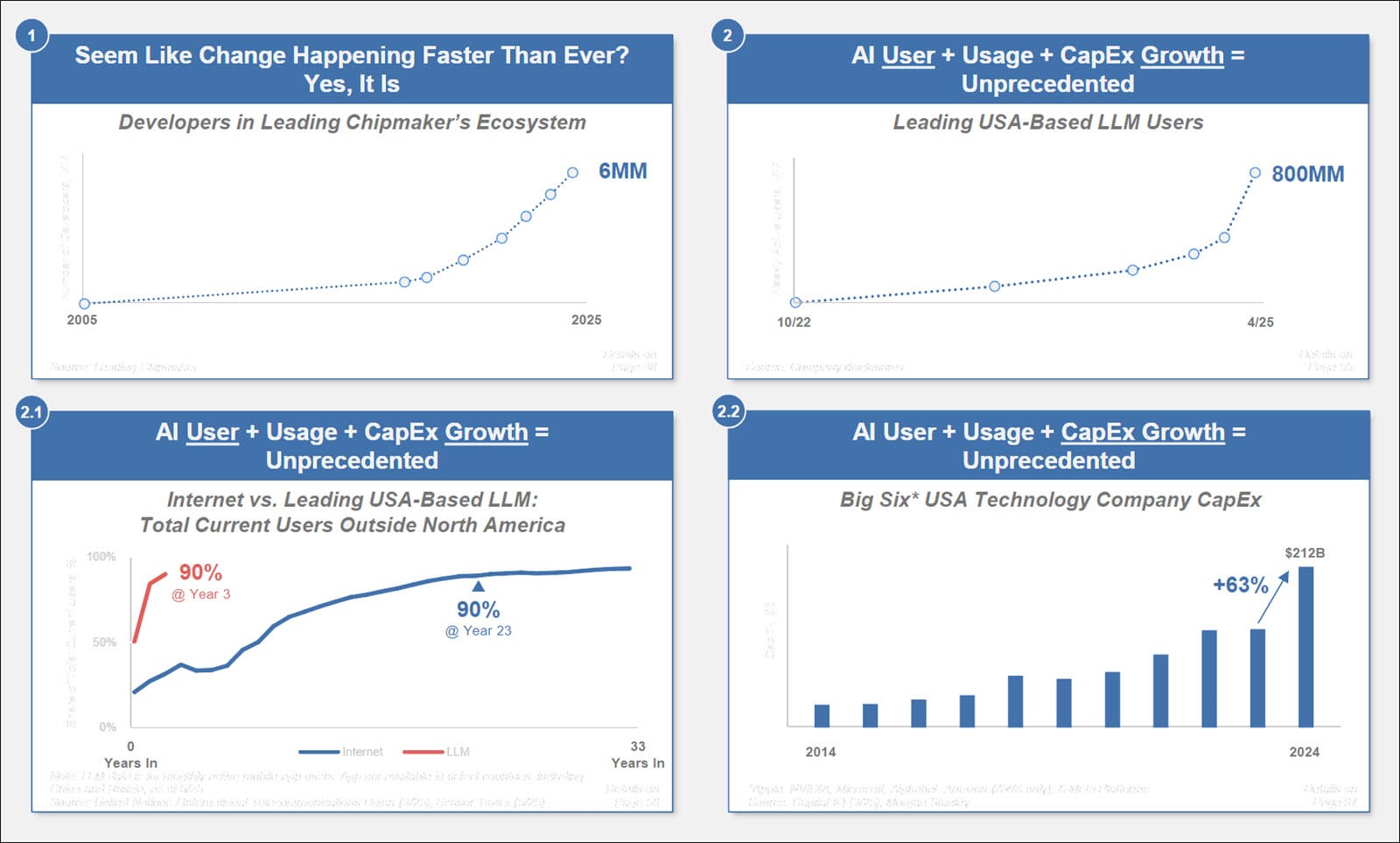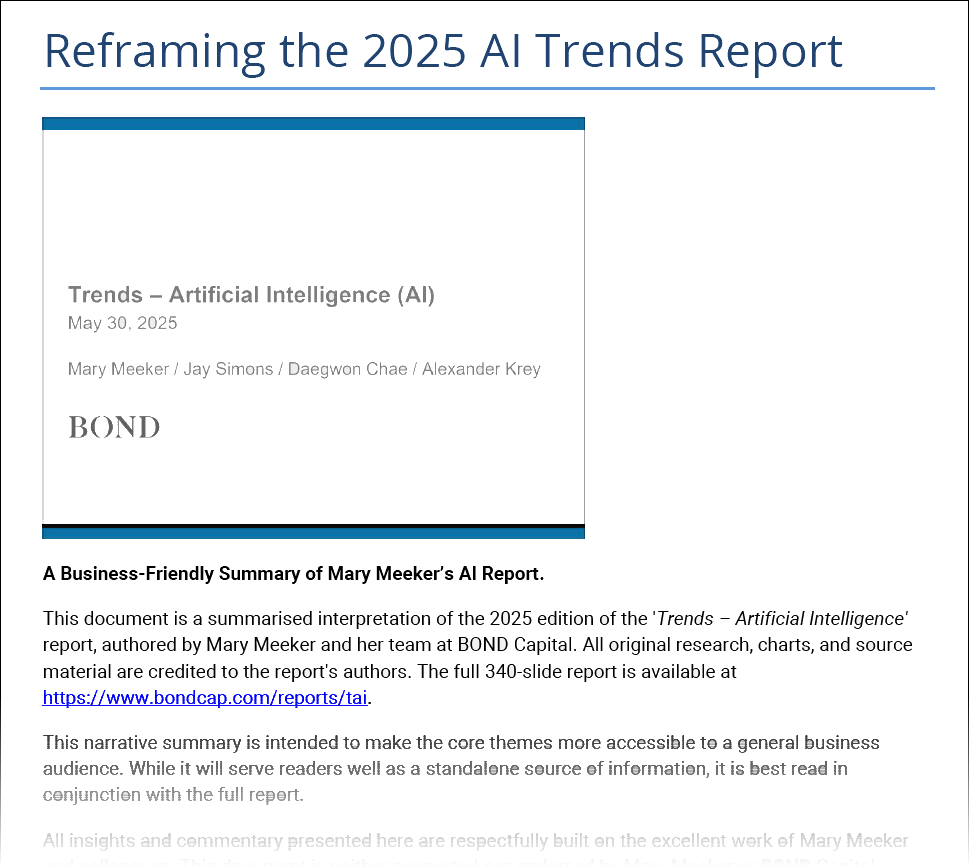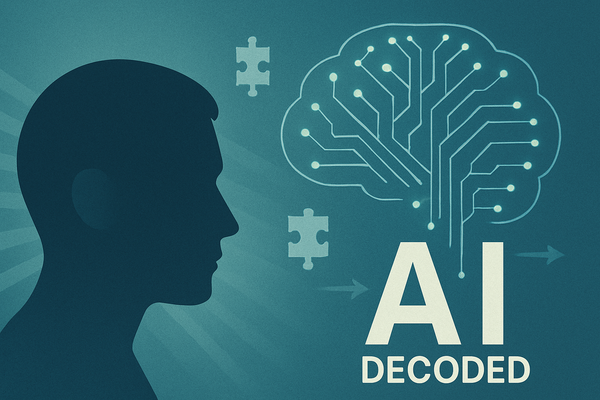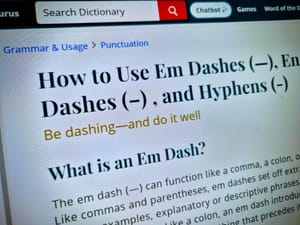For nearly 30 years, Mary Meeker has been synonymous with richly detailed, deeply researched annual trend reports, especially those that captured the pulse of the Internet era during the 2010s. As a venture capitalist and former Wall Street securities analyst specialised in Internet and new technologies, she was a highly influential voice on spotting big-picture trends before they came into focus.
Her last such report was in 2019. Now, after a six-year pause, she’s back – and this time her focus is squarely on artificial intelligence.
The Trends – Artificial Intelligence (AI) report, published by Meeker and her team at BOND Capital on 30 May, is a 340-page tour de force. It’s big, bold, and built for a Silicon Valley audience: tech investors, engineers, founders, and platform builders. Thus, its focus, tone, and overall presentation are designed for such an audience who would be familiar with the subject matter and a technical discussion of it.
But what if you’re not in that world?
What if you’re a communicator like me? Or a business strategist, business leader, or someone just trying to understand where this accelerating AI wave is heading, and how to prepare?
I want to understand what Meeker's chart-laden report signals for a lay audience, which is why I created an overview in plain language repurposed from the original in-depth report.
Lay Summaries
There is a clear thematic structure to Meeker's report that we can use to reinterpret it for a broader business audience. I've structured this around the eight core themes that the report addresses, and which is how my overview document (which you can download here: link further below) is presented.

In this post, I want to share my interpreted viewpoint on what I've gleaned from the report itself:
1. Change is Accelerating – Faster Than Ever
Lay summary:
The pace of change in AI outstrips even the Internet’s early growth. Technologies like ChatGPT reached global usage levels far faster than web or smartphone platforms. Businesses need to be alert to AI’s compounding speed and adoption.
- 📈 Implication: Strategic agility is essential – 5-year plans may need quarterly reassessment.
- 💬 Quote for context: “AI user and usage trending is ramping materially faster… and the machines can outpace us.”
2. User Growth, Usage, and Investment are Surging
Lay summary:
Billions are being spent by tech giants, startups, and sovereign states. ChatGPT hit 800 million users in under two years. Developers and users are flocking to AI tools at record speed.
- 💡 Implication: Organisations must consider how AI can improve customer experience, internal productivity, and innovation.
- 🔍 Note: Capital expenditure (CapEx) by the “Big Six” tech firms now tops $200B annually, much of it AI-focused.
3. Performance is Improving While Costs Drop
Lay summary:
While AI model training costs are high, the cost to use them is dropping sharply. This means more developers and companies can afford to build on top of powerful AI platforms.
- 🧠 Implication: Barrier to entry is lowering – expect AI-powered features to appear in everything from banking apps to chatbots to HR tools.
4. Usage, Costs, and Losses are All Growing
Lay summary:
AI companies are spending heavily and often operating at a loss to scale quickly. This is a classic tech land-grab phase, where user growth is prioritised over short-term profits.
- 🧮 Implication: Expect rapid innovation but also volatility. Partnerships or vendor choices should be scrutinised for long-term viability.
5. Monetisation is Complex – Open-Source, China, and Competition Rising
Lay summary:
The AI space isn’t a monopoly. Open-source models and strong competitors from China are challenging US dominance. There’s also debate over who gets paid and how in the AI value chain.
- 🌏 Implication: Competitive pressures may keep costs down for users, but IP issues, security concerns, and vendor lock-in remain key risks.
6. AI is Merging With the Physical World
Lay summary:
From driverless taxis in San Francisco to robotics in China, AI is moving beyond screens. Hardware and real-world interfaces (like voice, vision, and touch) are part of the next wave.
- 🚗 Implication: Sectors like logistics, manufacturing, and healthcare will experience transformation – and potential disruption – first.
7. AI-Driven Growth in Internet Usage is Historic
Lay summary:
AI is driving a new wave of Internet activity, with large-scale adoption across emerging markets. Many people are coming online primarily to use AI tools.
- 🌐 Implication: Business models must assume a global, AI-native audience with different expectations and capabilities.
8. Work is Evolving Rapidly
Lay summary:
AI is reshaping job roles – especially in IT, marketing, and knowledge work. Job postings for AI roles are up over 400%, while non-AI tech roles have declined slightly.
- 🧩 Implication: Re-skilling, up-skilling, and redefining roles will be central to talent strategies. Communicators must be change agents here.
Why This Matters for You
This isn’t just about tech. It’s about the shifting foundations of business, behaviour, and society.
If you work in communications, marketing, HR, operations, or leadership:
- Your employees are using AI, with or without policy.
- Your customers expect faster, smarter, more tailored interactions.
- Your competitors are building new capabilities you might not see coming.
Understanding these trends at a practical level isn’t just useful – it’s essential.
Download the Full Summary

The 18-page business-friendly, plain-English summary PDF of all eight themes from the 2025 AI Trends report I created is ideal if you want clarity without 340 slides of an investor deck.
AI is advancing rapidly, and the rest of us need to keep pace. Hopefully, this helps.
I’d love to hear what resonated with you – did I miss anything you think should be included? – and how your organisation is approaching AI. Feel free to leave a comment.
Postscript 6/6/2025: A Conversation Worth Listening To
After publishing this summary of Mary Meeker’s AI Trends 2025 report, I had the chance to sit down with my podcasting partner, Shel Holtz, for a short-form episode of For Immediate Release to unpack it further.
In our 25-minute conversation, we focused on what Meeker’s 340-slide deck means beyond the investor and tech circles it’s clearly aimed at. We explored why this report matters to communicators and business leaders, and what practical steps they can take now.
We noted that, with credibility as strong as Meeker's, it’s likely that this report will become the defining source of truth about the state of AI.
Key points we discussed:
- The unprecedented speed of AI adoption, and why organisations must adapt on much shorter cycles.
- How the report signals a fundamental shift in the nature of work – and the role of internal communication in navigating that change.
- The growing importance of AI literacy, not just for IT teams but across the entire organisation.
- Why the next wave of customers and employees may be AI-first, not Internet-first, and how that reshapes experience design.
If you’d like to hear a distilled, conversational take on the report, do give it a listen.

Visit the podcast show notes page for the video version and the verbatim transcript.




















